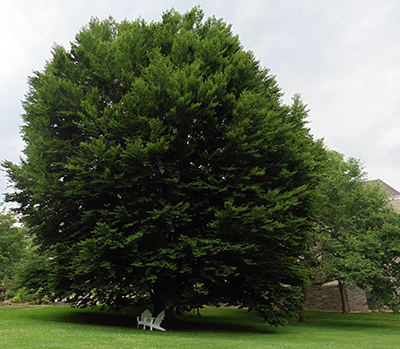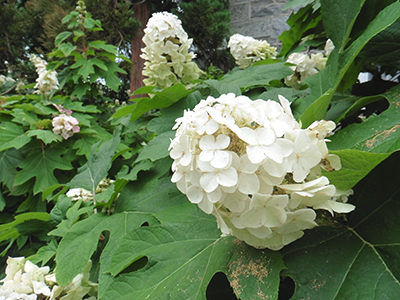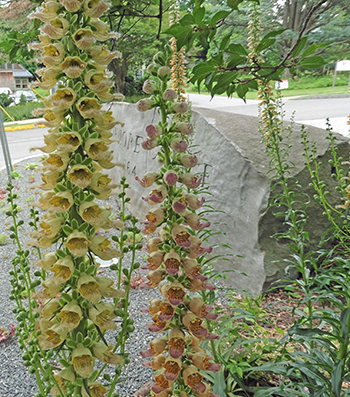
Plants of the Week: July 2

Fagus sylvatica
As the days of summer get hotter, finding respite in a shady spot becomes more important! One of my favorite shady spots on campus is an Adirondack chair beneath the canopy of the European beech, Fagus sylvatica, outside McCabe Library. Its round crown is almost like an umbrella and its dense leaves give protection from the sun’s heat.
European beeches are notoriously long-lived. They are known to live up to 500 years, and pollen from an Iron Age European beech has been found in England, possibly introduced by Vikings. While it takes many years for a tree to become as majestic as the one on campus (planted many, many years ago, but accessioned to our collections in 1980) you can plant one if you admire its smooth bark and bright green leaves. European beech is more tolerant of its pH than the American beech, and transplants well. It prefers well-drained soil and has few pest or disease problems. Plant one now, to invest in the enjoyment of generations to come. Photo credit: E. Fogarty

Hydrangea quercifolia ‘Snow Queen’
Many people immediately think of macrophylla or serrata species when they hear about hydrangeas – the ones with thick balls of flowers which change color depending on the pH of the soil. Although they are a welcome addition to any landscape, I think the oakleaf hydrangea,Hydrangea quercifolia, in particular ‘Snow Queen’, deserves more praise than it’s usually given.
Named because its large, lobed, dark-green leaves that resemble those of an oak, these woody shrubs feature cones of white blooms that stay white regardless of the soil pH. The oakleaf hydrangea is native to this area. A mention of it can be found in William Bartram’s 18th century journals.
Hydrangea quercifolia is low-maintenance requiring well-drained soil. The flowers fade to tan by the end of summer. The leaves present a glorious show of red in the fall, giving it another season of interest. The bark is interesting when the leaves finally fall. You can find oakleaf hydrangeas behind the arbor in the Terry Shane Teaching Garden and between Parrish Hall and the Rose Garden Circle. Photo credit: E. Fogarty

Digitalis ferruginea
I have a fondness for historic medicinal plants, so when these beautiful foxgloves popped up by the Swarthmore Entrance Rock and in front of Cunningham House, I was smitten. With its pale yellow-to-orange blooms, Digitalis ferruginea, rusty foxglove, plants are certainly less showy than its D. purpurea relations, but is equally beautiful.
The foxglove as medicine was first mentioned in the late 18th century; however, Digitalis ferruginea can be seen in 16th century herbologies. Foxgloves didn’t become important until much later when a compound called digitalin was extracted from it and used in heart medicines to combat arrhythmia. It must be noted that although this is used in medication, it should not be ingested, and modern herbalists have abandoned it completely. Although in certain doses this plant can stop arrhythmia, it can just as easily propel it into motion, leading to its dual use as a poison that was especially popular in the Middle Ages. This plant is a lovely addition to any garden—just be sure to give it partial shade and well-drained soil. Photo Credit: E. Fogarty





No Comments